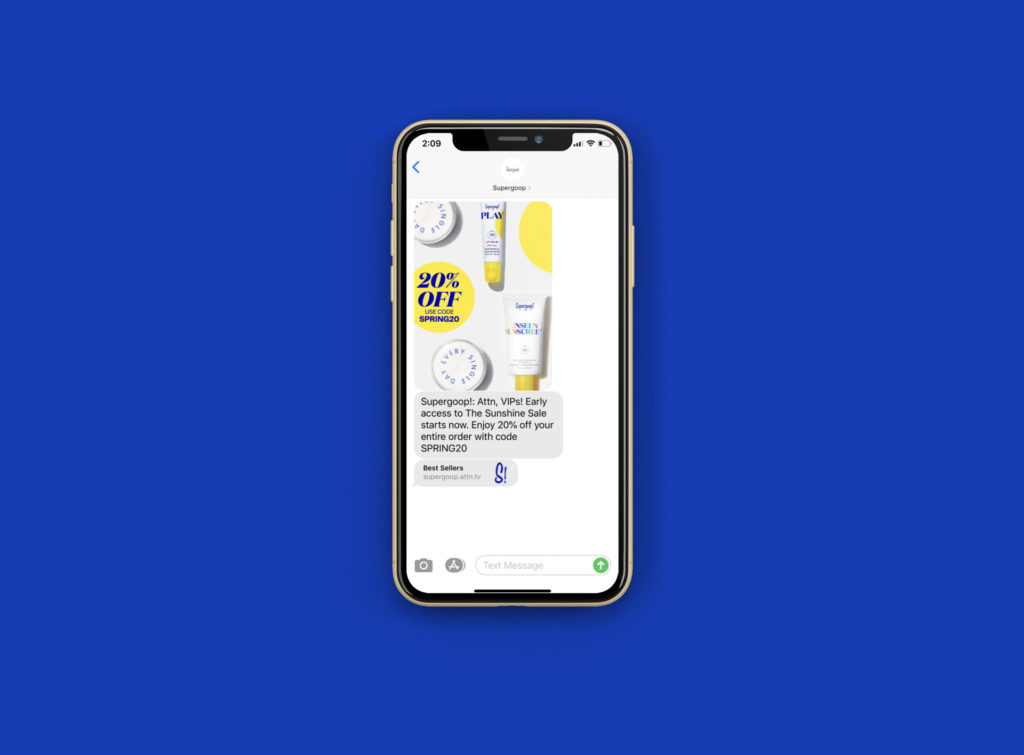SMS Archives FAQ
What is text message marketing?
Text message marketing is the broad term for a combination of commercial text messaging related practices. Most brands, when they talk about text message marketing, mean the practice of sending mass text message alerts to interested consumers. You can compare text message marketing with email marketing, except instead of emails, brands send out text messages to consumers who have opted in to a text message marketing campaign.
Text messages (also referred to as SMS or MMS messages) are small mobile messages that people and brands send to mobile phones. Usually, these messages contain limited characters (up to 160 characters for SMS messages or 5,000 characters for MMS messages) and are made up of text, clickable phone numbers, and links.
What is the difference between SMS and MMS?
SMS and MMS refer to the two main types of text messages that brands can send. In short, MMS messages give brands a wider range of features than SMS messages. The three biggest differences between MMS and SMS messages are:
- Subject lines. An MMS message allows brands to utilize a subject line, like the example below. The subject line can be up to around 40 characters, which allows a brand to hook the customer and entice them to keep reading the message. On some mobile phones, the subject line is also bold, so it really attracts the subscriber’s attention to the message. In an SMS message, a subject line is not an option.

- Character limits. In an SMS message, there’s a limit of 160 characters per message. With an MMS message, brands can send up to 5,000 characters of text, as you can see in the example below. This gives organizations the opportunity to fully get their message across.

- Media content. MMS messaging allows brands to include a file or media content, like the example below. Popular media examples include video, image, GIF, vCard, or even a sound file. This is why a lot of brands choose MMS over SMS messaging, as they can be more eye-catching and allow brands to showcase their products more visually.
 Many brands prefer MMS messages, as they have more opportunity for creativity in order to catch the eye of the consumer. However, both SMS and MMS messages are ways that companies and organizations can communicate with their subscribers.
Many brands prefer MMS messages, as they have more opportunity for creativity in order to catch the eye of the consumer. However, both SMS and MMS messages are ways that companies and organizations can communicate with their subscribers.
Are there rules for what can and cannot be sent to consumers?
The short answer is: yes. There are many best practices for sending text messages to consumers, a few of which include:
- Display clear calls-to-action. All text messages marketing programs must display a clear call-to-action when consumers sign up, such as: “Get 20% off when you sign up for our text message marketing program.” Consumers must be made aware of what exactly they are signing up for when opting in to receive text messages.
- Offer clear opt-in mechanisms. Consumers must also consent clearly to opt in to all recurring messages programs. Requiring a customer to enter a mobile phone number does not constitute a compliant opt-in. Instead, customers must understand that they will receive messages at their phone number, and consent to receive those messages.
- Send opt-in confirmation messages. A confirmation message must be sent to customers to confirm that they want to receive text messages from a brand. For recurring messaging programs, confirmation messages must include clear opt-out instructions so consumers know how to unsubscribe if they wish to.
- Acknowledge opt-out requests. Text message marketing providers must acknowledge and act on all opt-out requests. Monitoring procedures help confirm successful opt-out.
Now, there’s more to it than that. To fully understand the breadth of text message marketing laws, it’s helpful to know the players. There’s a lot of confusion and misinformation in text message marketing about laws, compliance, and best practices. The majority of the confusion comes from businesses not knowing the difference between the governing bodies — the CTIA, the FCC, and the MMA — and the role that each of them plays in text message marketing. To help you more fully understand text message marketing rules, below is a deeper understanding of each organization, and how they impact the laws of text message marketing.
- Cellular Telecommunications and Internet Association (CTIA)
The CTIA is an organization that was created by the wireless carriers to enforce proper SMS marketing practices to make sure they’re in the best interests of the consumer. The CTIA guidelines are very specific about text message marketing. They tell you exactly what must be included in an advertisement for an SMS program (i.e. message and data rates, help and stop commands, message frequency, links to terms and conditions, privacy policies, etc.) as well as what must not be included. Since the CTIA guidelines aren’t officially SMS marketing law, you can’t be sued for violating them, but you do run the risk of having your SMS program shut down. - Federal Communications Commission (FCC)
While the CTIA guidelines aren’t SMS marketing law, the TCPA (developed by the FCC) is federal law. No business has ever been sued for not following CTIA guidelines, but countless brands have been sued under the TCPA, including large brands such as Jiffy Lube and Papa John’s. Unlike the CTIA, which is very specific, nothing in the TCPA specifically targets text message marketing. In fact, the TCPA doesn’t actually mention text messaging at all. Text messaging was only recently mentioned by the FCC in a clarification issued regarding whether or not the TCPA applies to text message marketing (it does). There’s no mention in the TCPA of message and data rates or what must be included in a text message when a consumer texts the word “HELP” to a short code. The TCPA SMS marketing laws are all about brands receiving permission from consumers to text message, the specifics of how this permission can be obtained, and what is allowed after permission has been granted. - Mobile Marketing Association (MMA)
Lastly, there’s the Mobile Marketing Association (MMA), which releases its own SMS marketing best practices document that is very similar to the Mobile Commerce Compliance Handbook that the CTIA puts out. The MMA best practices for SMS marketing aren’t SMS marketing law, like the TCPA is, and they aren’t enforced by anyone, so these best practices add more confusion to the industry than clarification.
If that sounds overwhelming, we’ve combined the text message marketing laws from the CTIA and TCPA into one set of easy-to-understand and implement templates. Download the templates (six total) for free here so you’re clear on exactly how to structure text messages to be within the legal guidelines and industry best practices.
How often can I send texts to my subscribers?
The frequency of your brand’s text messages depends on the application and situation. To gain a better understanding of how often text messages should be sent, the brand can use customer data, like purchase frequency, to help determine how often a subscriber may want to receive messaging.
For example, if a quick-service restaurant like Chipotle wanted to determine how often they should send marketing messages to their subscribers, they may want to see how often their customers visit the restaurant. If the average customer purchased a burrito once a week, sending a message once or twice a week would be the right cadence for their messaging.
In a different scenario, a car dealership’s customer is much different than a quick-service restaurant. Due to the nature of the industry and business, customers visit dealerships once every few months for an oil change or car maintenance. So the messaging cadence of a dealership would be much different than a restaurant; while Chipotle could send a message once or twice a week, a car dealership could send a message once or twice a month.
Ultimately, the frequency in which SMS marketing messages should be sent depends on the nature of the industry, business, seasonality, and much more. A car dealership might send one or two messages during the off-season, but increase its messaging during the summertime. After all, the key to successful text message marketing is understanding a brand’s customers as best as possible, and delivering the right message at the right time, place, and frequency.
What is a short code?
A short code is a 5- to 6-digit phone number that is used by brands to run their text message marketing campaigns. Consumers can opt in to these campaigns by texting a keyword to a brand’s short code. In order for a consumer to interact with a short code, the consumer would simply compose a new text message on their cell phone and address it to a brand’s short code. The brand could then send text messages to these opted-in subscribers, typically containing coupons, offers, company communications, and promotions.